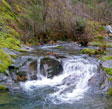November, 2001
Commissioners tell me they like to read mail from the public; even that they always read it. To comply with current submission guidelines and the stringent 1993 Ex Parte rules and do it quickly, I worked out a system with advice of Post Office staff.
Any letter and accompanying photos and documentation sent to the Coastal Commission by the public must go to all Commissioners, alternates, and non-voting members, and also to staff at the same time. Cost: It will cost $100 and up depending on the number of color photocopies.
Timing: If an item is opened and continued, or you wish to comment on a Commission action or discussion, the mailing should go out the week after the Commission meeting. If the item is upcoming, the mailing should go out at the very latest by Monday of the week before the meeting, so it will reach Commissioners in time for them to study it over the weekend.
Contents: Your letter and attachments plus visuals. Staff reports reproduce photos badly; photos help you show your issue. Showing slides at meetings can be problematic. Some meeting halls are too bright or have bad projection systems. Mail color photocopies to Commissioners, the prettier the better. These can be color prints of slides you showed or will show at the meeting.
If your home computer system will not handle large numbers of prints, many Kinko’s or local copy shops do these for as little as 89-99 cents per page. Put the CCC file reference number for the case on every item.
Staff: Send it to the person whose name appears on the staff reports and to one or two San Francisco officers, such as Executive Director Peter Douglas and Deputy Director Steve Scholl or Chief Counsel Ralph Faust.
Commissioners: The list keeps changing and some addresses are very long. Go to the CCC website, www.coastal.ca.gov and on the main menu at the left side of the home page click on Commissioners Click on the button to see biographical sketches and some photos of Commissioners. Read these before writing your letter so you can reach out to real people.
Putting the mailing together. Go back to the roster and print it out. Cut out the addresses and use them as labels. Stick them down with a glue stick and cover them with clear package tape. Use manila envelopes, recycled are cheaper but new ones are faster. Start with 30 to 40 envelopes, depending on how many copies you will send to allies or legislators. Stick on your return address labels at upper left.
Commissioners may not open envelopes from the public unless they state on the outside that they were sent to staff too. Print out labels with the CCC file reference number for your item and All Contents sent to staff and stick these on the envelopes, down in a corner. Close the envelopes with more clear package tape, especially if they are clasp envelopes.
Send them Priority Mail. The P.O. will give you blocks of stickers ahead of time; stick these on. Take the mailing, which is now very tidy, to the P.O. The two or three envelopes addressed to staff must be sent Certified Mail, Return Receipt Requested. Staff loses public submissions. Fill out the green cards for this and stick them sideways on the manila envelopes, under your return address label. Fill out the Certified Mail stickers and put them on above the address of the recipient. You will have placed your Priority Mail stickers to leave room on the envelopes for these items.
Now you see why the P.O. wants you to use manila envelopes; 9 inches by 12 inches are minimum to fit on all the stickers. If you need a larger envelope your mailing is probably too thick for Commissioners to digest.
This system assures you that Commissioners are likely to open and read your material, that the P. O. will deliver it as fast as possible, and that you will do it because there is a system to follow. You can hand-write addresses, reference numbers and notice that it was sent to staff, but that is not as good for the Post Office.
To submit materials closer to the time of a meeting, at the meeting if you attend, or during the meeting via fax, let staff know ahead of time that you plan to do this, more or less what you will submit, and ask them the best way to do it. Such material usually goes into a supplement, which may be available only to Commissioners. Ask that copies of any supplement that deals with your issue be available at the front table at the meeting on the day of the hearing. Your issue is likely to be of interest to other activists in the state and they should be able to pick up copies of your submissions. If there are no copies available at the meeting, staff may have a copy that you can peruse.
Good luck, and as Sierra Club Coastal Campaign attorney Mark Massara says: Go to the beach!
 Friends of Gualala River Protecting the Gualala River watershed and the species living within it
Friends of Gualala River Protecting the Gualala River watershed and the species living within it
